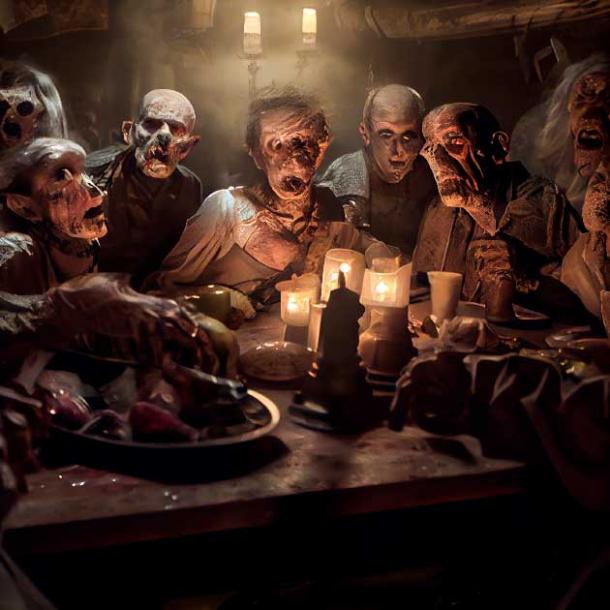
Ferdinand I Dressed Up His Murdered Enemies and Displayed Their Mummies
Throughout history, many rulers have turned to drastic measures to ensure success. But how many have created a museum of corpses to frighten their subordinates into following their commands? So far, only one is known of. Ferdinand I of Naples was known as a cruel and feared monarch during the 15th century, but one of the most fascinating parts of his rule was his collection of mummies. Here we reveal some of the dark details of Ferdinand’s rule and how his macabre museum of mummies came to be.
An Illegitimate Beginning
Ferdinand, universally known as Ferrante, had a unique path to the throne. His father, Alfonso I of Naples, was once the King of Aragon and the King of Sicily, and was the King of Naples until his death in 1458. His only successor was Ferdinand, his illegitimate son from a Neapolitan woman named Gueraldona Carlino. Alfonso wanted to prepare Ferdinand to inherit his throne someday, so he decided to invite Ferdinand to live with him, where he could be trained in his father’s work.
Alfonso was greatly impressed by his son’s courage and intelligence. After just a few months, he made Ferdinand a knight. Ferdinand took classes from several teachers throughout Naples to learn about different subjects necessary for him to take the throne someday. He did so well in his law lessons that Alfonso named him the president of the Sacro Regio Consiglio (Neapolitan court that provided judicial authority of the kingdom) once it was established.
Just a year later, Ferdinand was named the lieutenant general of his father’s kingdom. Alfonso was so pleased with his work that he legitimized Ferdinand just a few months later, publicly declaring him as the heir to his throne. He then made Ferdinand the Duke of Calabria in 1443, giving him further power within the region. Ferdinand eventually married and became King of Naples in 1458 at 35 years old.

Ferdinand I depicted as a member of the Order of the Golden Fleece (Public Domain)
A Bloody Fight for the Throne
Taking over for his father was no easy feat. Ferdinand had plenty of enemies he had to conquer to fully claim his right to the throne. Though his father had legitimatized him, this was not respected by several powerful men in the region who wished to claim the throne for themselves. In this fight, Ferdinand quickly learned that he had to vanquish those against him if he were to stand any chance as a powerful and respected ruler.
As he claimed victory after victory over his enemies, Ferdinand became more ruthless. He had less regard for the lives of his opponents than ever and sought success by any means necessary. While this stance made him seem powerful at first, he soon lost the respect of many individuals in his own kingdom, which eventually led to a revolt among the nobility. He defeated them swiftly, making his own people fear him. These fears became justified when he promised some of the spared nobles amnesties but later killed them anyways.
- Bones from the wealthy and privileged Medici children show they suffered from malnutrition
- Caterina Sforza: A Renaissance Warrior Woman That Knew How to Get What She Wanted

A posthumous portrait of Ferdinand of Naples (Artnet / CC by SA 4.0)
Thinking of Committing Treason? You May Become a Mummy
Because of the fear and doubt behind his reign, Ferdinand had to come up with alternative solutions to keep his followers in check. After so many attacks, he learned that a good rule of thumb was to keep your friends close, but your enemies closer. He took this rule so seriously that he even kept his enemies close to him in death.
Ferdinand had a museum built to collect the bodies of his defeated enemies. He called this collection the “black museum,” in which he would store his mummified foes to show off to other potential enemies. Once his enemies were killed, he commanded his servants to embalm them and dress them in casual clothes before being posed in the museum as if they were still living. This eerie display was enough to unsettle any of his guests, especially those considering betraying him. He particularly enjoyed bringing those he suspected of treason in for a tour, which usually prevented them from engaging in any more questionable behavior.
The black museum lasted for several years until his death in 1494, presumably due to the stress of his failing kingdom. However, this wasn’t the end of his story. Ferdinand’s last request was to be embalmed and dressed just like his mummies, so he could be preserved. Though he was not posed in the museum with the rest of his mummies, he was buried in a vault underneath Naples’ St. Domenico Maggiore church along with 30 other mummies estimated to have lived during the 15th and 16th centuries.
After discovering his mummified remains, researchers in the 1990s determined that he actually likely died of colon cancer. While this cancer growth may have simply been bad luck, researchers also discovered a significant amount of mercury in his hair, possibly an attempt to rid himself of lice. Frequent mercury use could have contributed to the development of his cancer, though this cannot be said for certain.
- Evicted from a Cemetery and into a Museum: The Multitude of Mummies of Guanajuato
- What Caused the Natural Mummification of the Mummies of Venzone?

Ferdinand of Naples dressed up his murdered enemies and displayed their mummies. Source: designprojects / Adobe Stock
Cruel But Fascinating
The idea of a museum of dressed, posed corpses is definitely an eerie one. In fact, the ruthless king and his chilling museum have been featured in a number of books and television shows including The Borgias, a Canadian show that ran between 2011 and 2013. Though the depiction in the show is not entirely accurate, it is accurate enough to give viewers a peek into the distorted mind of Ferdinand I of Naples. Though we may make enemies at times, let’s be grateful they aren’t as creatively twisted as the infamous King Ferdinand!
Top image: Medieval mummies. Source: designprojects / Adobe Stock
By Lex Leigh
References
The Aragonese mummies of the Basilica of Saint Domenico Maggiore in Naples - Scientific Figure on ResearchGate. Available from: https://www.researchgate.net/figure/La-tribuna-con-i-sarcofagi-reali-allinizio-delle-esplorazioni-1984_fig1_5673816 [accessed 12 Dec, 2022]
Elhassan, K. (2022, August 21). Brutal moments in history where Justice was served Ice cold. History Collection. Retrieved December 12, 2022, from https://historycollection.com/brutal-moments-in-history-where-justice-was-served-ice-cold/26/
Guardian News and Media. (2013, September 30). Scientists discover king Ferdinand had a double infestation of lice. The Guardian. Retrieved December 12, 2022, from https://www.theguardian.com/education/2013/sep/30/scientists-discover-king-lice
Howard, N. (2021, November 16). Ferdinand of Naples and his Museum of Mummies. Medium. Retrieved December 12, 2022, from https://medium.com/the-history-inquiry/ferdinand-of-naples-and-his-museum-of-mummies-c2426fbf63d3
This Italian king went all 'Game of thrones' on his enemies. We Are The Mighty. (2018, April 2). Retrieved December 12, 2022, from https://www.wearethemighty.com/articles/this-italian-king-went-all-game-of-thrones-on-his-enemies/















